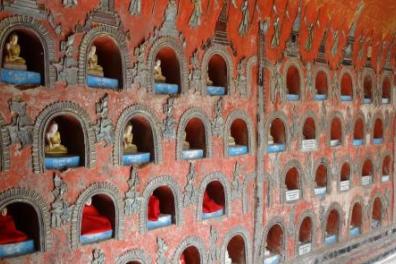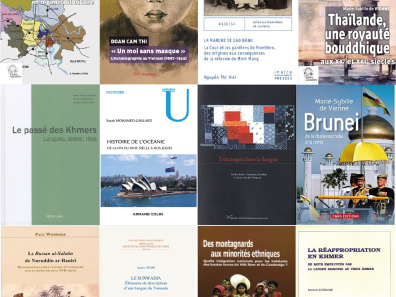Some non-exhaustive references

To complete this dossier on the research work of the ASEP department, here are the latest publications by our research colleagues.
Allès, Delphine: Premises, Policies and Multilateral Whitewashing of Broad Security Doctrines: A Southeast Asia-Based Critique of "Non-traditional" Security, ERIS - European Review of International Studies, 1-2019, pp. 5-26. https://doi.org/10.3224/eris.v6i1.01
This article highlights the extensive approaches to security formulated in Indonesia, Malaysia and then within the framework of the Association of Southeast Asian Nations (ASEAN), long before they were conceptualized in the academic field. Broad conceptions, extending the definition of security to socio-economic issues, formed the basis for the consolidation of state and military apparatuses in the region. This history tends to be overlooked by analyses praising the conversion of Southeast Asian political elites to the discourse of "non-traditional security", perceived as an innovation that should lead to deeper multilateral cooperation. In terms of the history and usage of national strategic doctrines, which form the basis of the ASEAN discourse, non-traditional security is more a matter of semantic evolution than political transformation. At the heart of the comprehensive security doctrine promoted at regional level, this concept has provided multilateral anointment for "broad" conceptions of security and the role of military apparatuses, whose extended socio-political functions it thus legitimizes.
Key words: Southeast Asia, non-traditional security, ASEAN, security studies.
De Vienne Marie-Sybille, "Les formules de consécration des dignitaires au Perak et au Brunei : enquête préliminaire sur l'origine et les fonctions du ciri", Péninsule n° 79, 2019 (2), pp. 107-168
The recitation of an invocation in "pseudo-Sanskrit", the ciri, survives to this day in Perak (Peninsular Malaysia) and Brunei when awarding curial dignities. In addition to the leaves preserved in these two sultanates, several manuscripts of the Sulalat al-Salatin (SS al. Sejarah Melayu) give the text of the ciri used at the enthronement of the founder of the Malaka dynasty. The synopsis of the ciri cited in the various SS manuscripts shows that they are variants of the same formula, thus opening up some leads as to the original titulature of the Malaka dynasty, particularly in relation to the kingdom of Malayu and Ādityavarman's kinship. A study of the six ciri dating from the 19th century used in the awarding of curial dignities, one in Perak and the other five in Brunei, reveals conversely quite distinct origins, those of Brunei being partly written in Arabic. The existence of a 'Perakian' model of ciri suggests that some of the ciri in force in the Malay world would have been preceded by a preamble, the use of which would have been maintained only in Perak. The pseudo-Sanskrit part of the Bruneian ciri remains closer to the ciri of the SS. The contributions of this approach can only invite us to cross-reference manuscript, epigraphic and archaeological sources, and more broadly to compare them with contemporary Malay palatial rites.
De Vienne Marie-Sybille (Inalco) & Jérémy Jammes (Universiti Brunei Darussalam), "China at the 'epicentre' of Southeast Asia - Economic and Geostrategic Challenges of the Belt and Road Initiative in Brunei", in press (September 2020), Asian Survey (Berkeley), 27 ff.
At the 17th ASEAN Regional Forum, Chinese Minister of Foreign Affairs Yang Jiechi reminded all that "China is a big country and all the other countries are small countries; this is a fact". Though Brunei is the smallest of all ASEAN States according to both its population and GDP, the level of Chinese investment (cumulated direct investment and construction contracts divided by 2018 GDP) in the sultanate is much higher than in most other ASEAN states. The present paper analyses the BRI stakes for both Brunei and China and Brunei's response to the Chinese proposals, showing that in spite of its smallness, the sultanate seems still able to preserve its own interests up to a certain extent thanks to its balanced foreign policy and its financial resources.
De Vienne Marie-Sybille, "Le 'grand jeu' chinois face aux identités locales : l'État Shan, un nœud géostratégique, 1948-2019", in Pierre Journoud & Antoine Coppolani (éds.), Un Triangle Strategique à l'épreuve : la Chine, les États-Unis et l'Asie du Sud-Est, de 1947 à 2017, Montpellier, PULM, in press, 4th quarter 2020, 16 ff.
Faced with the unrest that has agitated the Shan State since 1948, China has changed its posture four times. In 1952, its priority was to thwart Kuomintang infiltration. During the Cultural Revolution, China played a subversive role through the Burmese Communist Party (BCP), which took control of the border area. Following Deng Xiaoping's accession to power (1977), it drew closer to Rangoon and drastically reduced its support for the PCB. The rapprochement became a partnership at the end of 1989, sealing the PCB's demise. Myanmar's reintegration into the international community (2011) and the resumption of war in Shan State finally prompted it to support "normalization", while working to stabilize the areas through which part of its hydrocarbon supplies transit.
Duchère, Yves, 2019, Hà Nội and its region. Une géographie du compromis en régime autoritaire, Les Indes Savantes, 237 p.
https://www.lesindessavantes.com/ouvrages/24727
In Vietnam, urbanization is the modus operandi of the country's integration into the market economy. A real driving force behind the economy, urbanization also remains a strategic segment of the party-state's intervention, maintaining its hold on the political-administrative system and society. In the context of Hà Nội's "urban catch-up", peri-urban artisan villages are the site of socio-spatial recompositions specific to the city's metropolitan development, and are analyzed through an original, interdisciplinary approach. The study provides important keys to understanding the ways in which the CPV maintained power, postulating from the outset that the authorities' exercise of authoritarian power can be apprehended by analyzing the power relations at work in the urban fabric in Hà Nội. It is also proposed that the ability of the authorities to engage in dialogue by adapting and "groping", rather than subduing through force and repression, constitutes the ridge beam of the regime's stability. Starting from an empirical and spatialized research object, the demonstration aims to show how the governance of urban and peri-urban spaces in the metropolis of Hà Nội draws a particular geography. Authority, consent, compromise and governance are examined through three fields with different issues.
Fau Nathalie, Franck Manuelle (Dir.) : L'Asie du Sud-Est, Emergence d'une région, mutation des territoires, Armand Colin, coll Horizon, 2019, 448p.
https://m.armand-colin.com/lasie-du-sud-est-capesagregation-histoire-geographie-9782200626983
At the crossroads of two continents, Asia and Oceania, two demographic giants, China and the Indian subcontinent, and two oceans, the Indian and the Pacific, Southeast Asia forms the tropical end of the Asian continent. Comprising a peninsula and a string of islands, covering an area of 4,500,000 km² and populated by just over 600 million inhabitants, the region today comprises eleven countries, with a considerable diversity of sizes, populations, geographies, cultures and standards of living. Such complexity - particularly in socio-economic terms - even tends to call into question Southeast Asia's status as a region. The book therefore sets out to consider Southeast Asia as a whole, in order to identify its common features, by multiplying transversal and multiscalar approaches, without neglecting the specific features of each country. At the same time, two major issues - the geographical definition of the region on the one hand, and its economic development on the other - form the basis of the book, which is divided into five sections: "The emergence of a region", "Development models", "The limits of development", "Urban territories" and "The processes of regional integration". All the maps, diagrams, tables and graphs provided will give the reader a precise and in-depth knowledge of this region. This work of synthesis prepares for one of the geography questions on the CAPES and Agrégation.
Guérin, Mathieu, "Le stec trāñ' de Kampong Svay au milieu du XIXe siècle : officier du roi ou grand feudataire ? ", Péninsule, n°80, 2020.
The 19th-century Cambodian and French sources on Cambodia's Kampong Svay province enable us to study the power relations between the king's court in Oudong and then Phnom Penh, and the land to the north. The ukñā tejo Ey, cauhvāy sruk and ruler of this land, enjoys the protection of the King of Siam. When he loses this support, he moves closer to the French. His hold on his land extends far beyond his position in the royal hierarchy and his external supporters. Thanks to his own qualities, his kerti, and his ability to establish personal ties with his constituents, he was able to mobilize his clients to impose himself against the king. Power in Cambodia thus appears far more fragmented than the French were able to write when they established their domination over the country.
Guérin, Mathieu, " Notes de voyage cambodgiennes au Laos et au Siam", in Nathalie Kouamé, Eric P. Meyer, Anne Viguier (dir.), Encyclopédie des historiographies : Afriques, Amériques, Asies, Paris, Presses de l'Inalco, 2020, pp. 1298-1303.
In 1883, orientalist Étienne Aymonier commissioned a dozen Cambodian assistants to explore territories then considered Laotian under Siamese rule. The Khmer notes of these explorers constitute a corpus of exceptional quality now preserved at the Société asiatique. They describe the routes followed, the topography, hydrology and geography of the areas between Kratie and Vientiane, from the Khorat plateau to Attopeu. The authors, young Cambodian literati, were also archaeologists, stampers and ethnographers of the regions they visited, leaving behind a Cambodian vision of the Siamese and Laotian areas at the end of the 19th century. Despite their interest for historians and anthropologists, these difficult-to-decipher and often off-putting field writings remain little used.
Guérin, Mathieu, "Protecting the forest and its wildlife from the natives in British Malaya", Péninsule, n°75, 2017, p. 37-71.
At the beginning of the 20th century, the British government took up the issue of conserving its empire's wildlife. Policies were devised to set aside large tracts of land within British-ruled territories as nature reserves, wildlife sanctuaries and national parks. In Malaya, the main proponent of this effort was former big game enthusiast Theodore Hubback. In particular, he was behind the creation of two vast protected areas in the sultanate of Pahang: the Krau Wildlife Reserve and the King George V National Park. These projects affected local populations, whose rights to use the forests and their products were limited. Nevertheless, sources show that with the help of the sultans, notably Sultan Abu Bakar of Pahang, the forest peoples and Malay villagers were able to defend their grievances, which were taken into account in the drafting of the regulations applicable to the national park and reserves. Far from being dictated to by the colonial authorities, the establishment of the protected areas was the result of intense negotiations between different currents within the British administration, local populations, sultans and their courts. Conservationists were forced to make concessions, which in the long term strengthened the effectiveness of these areas for wildlife protection.
Nguyen Thi Hai (2018), La marche de Cao Bằng: La Cour et les gardiens de frontière, des origines aux conséquences de la réforme de Minh Mạng, Paris, Presses de l'Inalco, 292 p.
Situated on Vietnam's northern border and endowed with rugged terrain, the province of Cao Bằng, land of the Tày, was long considered a remote, barbaric, unhealthy and potentially dangerous area for the Kinh from the delta. To properly administer this frontier zone, the sovereign had to accept the privileges of the native chiefs, while maintaining his own prerogatives such as symbolic elements. But, from 1820 onwards, aiming to integrate this region into the country's official administrative system, Emperor Minh Mạng (1820-1840) carried out a policy to eliminate the power of the border guards. This reform is considered the first, and indeed the most violent, offensive by central power against indigenous chiefs in mountainous areas. This monograph offers a fresh look at the relationship between the monarchy and the local powers of Cao Bằng, the process of integrating the frontier marches of northern Vietnam, and the difficulties encountered by the Hué court in its management of the frontier regions.
